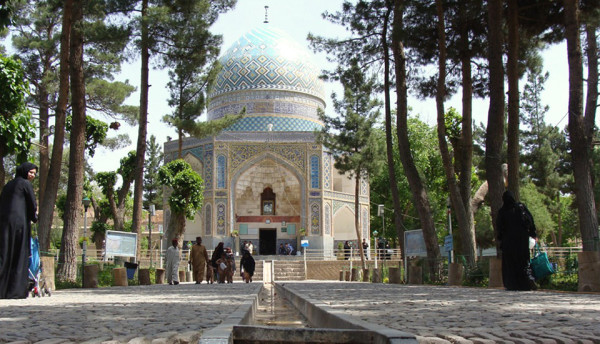
ಸೇಕ್ರೆಡ್ ನೈಸರ್ಗಿಕ ಸೈಟ್ಗಳು ಇನಿಶಿಯೇಟಿವ್ ನಿಯಮಿತವಾಗಿ ಉಸ್ತುವಾರಿ 'ಸಂರಕ್ಷಣಾ ಅನುಭವಗಳು "ಒಳಗೊಂಡಿದೆ, ರಕ್ಷಿತ ಪ್ರದೇಶ ವ್ಯವಸ್ಥಾಪಕರು, ವಿಜ್ಞಾನಿಗಳು ಮತ್ತು ಇತರರು. ಈ ಪೋಸ್ಟ್ Ms ಅನುಭವಗಳನ್ನು ಒಳಗೊಂಡಿದೆ. ಟೆಹ್ರಾನ್ ವಿಶ್ವವಿದ್ಯಾಲಯದಲ್ಲಿ ತನ್ನ ಸ್ನಾತಕೋತ್ತರ ಪ್ರಬಂಧದ ಸಮಯದಲ್ಲಿ ಮರಿಯಮ್ ಕಬಿರಿ ಹೆಂಡಿ ಇರಾನ್ನಲ್ಲಿ ಆಧ್ಯಾತ್ಮಿಕ ಮೌಲ್ಯಗಳೊಂದಿಗೆ ನೈಸರ್ಗಿಕ ತಾಣಗಳ ಸಂರಕ್ಷಣೆಗಾಗಿ ಭೂ ಮೌಲ್ಯಮಾಪನದಲ್ಲಿ ಕೆಲಸ ಮಾಡಿದರು.. With the help of Associate Professor Mr. Afshin Danehkar also from Tehran Universty, she also translated the IUCN UNESCO core guidelines for protected area managers on sacred natural sites into Persian. ಪೂರ್ಣ ಕೇಸ್ ಸ್ಟಡಿ ಓದಲು ಇಲ್ಲಿ ಕ್ಲಿಕ್ ಮಾಡಿ "Neyshabur ಆಧ್ಯಾತ್ಮಿಕ ಮೌಲ್ಯಗಳು ನೈಸರ್ಗಿಕ ತಾಣಗಳು ಸಂರಕ್ಷಣೆಗಾಗಿ ಜಮೀನು ಮೌಲ್ಯಮಾಪನ Township”.
ನೇಶಾಬರ್ ಈಶಾನ್ಯ ಇರಾನ್ನಲ್ಲಿರುವ ಪಟ್ಟಣ. ಅದರ ಬಹುಪಾಲು ಭಾಗವು ಬೆಟ್ಟಗಳು ಮತ್ತು ಪರ್ವತಗಳಿಂದ ಆವೃತವಾದ ವಿಶಾಲವಾದ ಸರಳದಲ್ಲಿದೆ. ಟೌನ್ಶಿಪ್ನಲ್ಲಿ ವಿಭಿನ್ನ ಪವಿತ್ರ ನೈಸರ್ಗಿಕ ತಾಣಗಳಿವೆ, ಪವಿತ್ರ ಮರಗಳು ಮತ್ತು ಪವಿತ್ರ ಬುಗ್ಗೆಗಳಿಂದ ಹಿಡಿದು ಪವಿತ್ರ ಬಂಡೆಯ ಮತ್ತು ಪವಿತ್ರ ಉದ್ಯಾನಗಳವರೆಗೆ. ಈ ಪ್ರದೇಶವು ಹಲವಾರು ಸ್ಥಳೀಯ ಸಸ್ಯ ಮತ್ತು ಪ್ರಾಣಿ ಪ್ರಭೇದಗಳನ್ನು ಹೊಂದಿದೆ. It also contains protected eco-tourism destinations such as waterfalls, ಬುಗ್ಗೆಗಳು, ನದಿಗಳು ಮತ್ತು ಕಣ್ಣು ಹಿಡಿಯುವ ಪರ್ವತ ಶೃಂಗಸಭೆಗಳಂತಹ ಭೌಗೋಳಿಕ ಲಕ್ಷಣಗಳು.

ಇರಾನ್ನ ಖೋರಾಸನ್ ರ z ಾವಿ ಪ್ರಾಂತ್ಯದ ನೇಶಾಬೂರ್ ಟೌನ್ಶಿಪ್ನಲ್ಲಿರುವ ಖಾದಮಗ ಉದ್ಯಾನ, ಪುರುಷ ಆಧ್ಯಾತ್ಮಿಕ ನಾಯಕ ಮುಹಮ್ಮದ್ ವಂಶಸ್ಥನೆಂದು ಭಾವಿಸಿದ, ಮನುಷ್ಯರಿಗೆ ಮಾರ್ಗದರ್ಶನ ನೀಡಲು ದೈವಿಕವಾಗಿ ನೇಮಕಗೊಂಡಿದೆ. ಖಾದಮ್ಗಾ ಎಂಬ ಪದವು ಹೆಜ್ಜೆಗುರುತು ಎಂದರ್ಥ ಮತ್ತು ಈ ನಿರೂಪಣೆಯನ್ನು ಸೂಚಿಸುತ್ತದೆ. ಮೂಲ: ಮರಿಯಮ್ ಕಬಿರಿ ಹೆಂಡಿ, 2011.
ಸ್ಥಳೀಯ ಜನರು ತಮ್ಮ ಧಾರ್ಮಿಕ ನಂಬಿಕೆಯಲ್ಲಿ ಬೇರೂರಿರುವುದರಿಂದ ನೈಸರ್ಗಿಕ ಲಕ್ಷಣಗಳನ್ನು ಗೌರವಿಸುತ್ತಾರೆ. ಉದಾಹರಣೆಗೆ ನ್ಯೂಲರ್ ಚಿತ್ರಾತ್ಮಕದಲ್ಲಿ ಸ್ಟೆಪ್ನಾಕ್ಸ್, ಪರ್ಷಿಯನ್ ಉದ್ಯಾನವಾಗಿದ್ದು, ಪ್ರಕೃತಿಯನ್ನು ಆಧ್ಯಾತ್ಮಿಕ ಮೌಲ್ಯಗಳಿಂದ ತುಂಬಿಸಲಾಗಿದೆ. ಇದು ಒಂದು ಮಹಲು ಒಳಗೊಂಡಿದೆ, ಮರಗಳು, ಕೊಳಗಳು ಮತ್ತು ಹೊಳೆಗಳು. ಭವನದ ಗೋಡೆಗಳಲ್ಲಿ ಒಂದು ಕಪ್ಪು ಕಲ್ಲು ಇದ್ದು ಅದರ ಮೇಲೆ ಎರಡು ಹೆಜ್ಜೆಗುರುತುಗಳನ್ನು ಕೆತ್ತಲಾಗಿದೆ. ಈ ಮುದ್ರಣಗಳು ಶಿಯಾಗಳ 8 ನೇ ಇಮಾಮ್ಗೆ ಸೇರಿವೆ ಎಂದು ಜನರು ನಂಬುತ್ತಾರೆ, ಪುರುಷ ಆಧ್ಯಾತ್ಮಿಕ ನಾಯಕ ಮುಹಮ್ಮದ್ ವಂಶಸ್ಥನೆಂದು ಭಾವಿಸಿದ, ಮನುಷ್ಯರಿಗೆ ಮಾರ್ಗದರ್ಶನ ನೀಡಲು ದೈವಿಕವಾಗಿ ನೇಮಕಗೊಂಡಿದೆ. ಖಾದಮ್ಗಾ ಎಂಬ ಪದವು ಹೆಜ್ಜೆಗುರುತು ಎಂದರ್ಥ ಮತ್ತು ಈ ನಿರೂಪಣೆಯನ್ನು ಸೂಚಿಸುತ್ತದೆ.
Formal ಪಚಾರಿಕ ನಿರ್ವಹಣಾ ತಂತ್ರ ಇದ್ದರೂ, local people still conserve lesser-known sacred sites. ಅಂತಹ ತಾಣಗಳ ಮೌಲ್ಯಗಳನ್ನು ಯುವ ಪೀಳಿಗೆಗೆ ಕಲಿಸಲಾಗುತ್ತದೆ ಮತ್ತು ಧಾರ್ಮಿಕ ಸಮಾರಂಭಗಳು ಮತ್ತು ಅಭ್ಯಾಸಗಳನ್ನು ಕೋಮುವಾದವಾಗಿ ನಡೆಸಲಾಗುತ್ತದೆ, ಅವರು ಶತಮಾನಗಳಿಂದಲೂ ಇದ್ದಂತೆ. ಈ ಕಡೆ, ಮುಂದಿನ ಪೀಳಿಗೆಯು ಅವರನ್ನು ರಕ್ಷಿಸಲು ಕಲಿಯುತ್ತದೆ.
ಇರಾನ್ ಶಾಸನಕ್ಕೆ ಇದುವರೆಗೆ ಪವಿತ್ರ ನೈಸರ್ಗಿಕ ತಾಣಗಳ ಬಗ್ಗೆ ಯಾವುದೇ ಉಲ್ಲೇಖವಿಲ್ಲ. ಕೆಲವು ಪವಿತ್ರ ನೈಸರ್ಗಿಕ ತಾಣಗಳನ್ನು ಅಧಿಕೃತವಾಗಿ ಸಂರಕ್ಷಿಸಲಾಗಿದೆ ಏಕೆಂದರೆ ಅವು ಸಂರಕ್ಷಿತ ಪ್ರದೇಶಗಳಲ್ಲಿ ಅಥವಾ ರಾಷ್ಟ್ರೀಯ ಸ್ಮಾರಕದಲ್ಲಿವೆ. ಇತರರನ್ನು ನಿರ್ದಿಷ್ಟವಾಗಿ ರಾಷ್ಟ್ರೀಯ ನೈಸರ್ಗಿಕ ಸ್ಮಾರಕಗಳಾಗಿ ನೋಂದಾಯಿಸಲಾಗಿದೆ. ಸಾಂಸ್ಕೃತಿಕ ಪರಂಪರೆ ಮತ್ತು ಪರಿಸರ ಪ್ರಾಧಿಕಾರದ ಇಲಾಖೆ ರಾಷ್ಟ್ರೀಯ ನೈಸರ್ಗಿಕ ಸ್ಮಾರಕದ ಸಂರಕ್ಷಣೆಯಲ್ಲಿ ಹೇಳಿದೆ. ಅವರು ಮುಖ್ಯವಾಗಿ ಅಪರೂಪದ ಸಸ್ಯ ಮತ್ತು ಪ್ರಾಣಿಗಳು ಅಥವಾ ಗಮನಾರ್ಹ ಭೂ ರಚನೆಗಳಿಗಾಗಿ ಪ್ರತಿಪಾದಿಸುತ್ತಾರೆ, ಭೂದೃಶ್ಯಗಳು ಅಥವಾ ಪ್ರಾಚೀನ ಮರಗಳು. ಸೂಕ್ತವಾದ ಪರಿಧಿಯನ್ನು ಗೊತ್ತುಪಡಿಸುವ ಮೂಲಕ ಅವುಗಳನ್ನು ರಕ್ಷಣೆಗೆ ತರಲಾಗುತ್ತದೆ.
If sacred natural sites they are to survive, ಪ್ರಸ್ತುತ ಕ್ರಮಗಳನ್ನು ಕಾನೂನು ರಕ್ಷಣೆಯಿಂದ ಬೆಂಬಲಿಸಬೇಕಾಗಿದೆ. ಈ ಉದ್ದೇಶಕ್ಕಾಗಿ, ಪ್ರಕೃತಿ ಮತ್ತು ಸಂಸ್ಕೃತಿಯ ಕ್ಷೇತ್ರಗಳಲ್ಲಿನ ಜಂಟಿ ಮಾನದಂಡಗಳು ಮತ್ತು ನೀತಿಗಳ ಆಧಾರದ ಮೇಲೆ ಸಮಗ್ರ ವಿಧಾನವನ್ನು ತೆಗೆದುಕೊಳ್ಳುವುದು ಪವಿತ್ರ ನೈಸರ್ಗಿಕ ತಾಣಗಳ ಸಂರಕ್ಷಣೆಯಲ್ಲಿ ಪ್ರಮುಖ ಪಾತ್ರ ವಹಿಸುತ್ತದೆ. ಎರಡು ನಂತರ (2011) ನೇಶಾಬೂರ್ ಪಟ್ಟಣದಲ್ಲಿ ಪವಿತ್ರ ನೈಸರ್ಗಿಕ ತಾಣಗಳ ಸಂರಕ್ಷಣೆಗಾಗಿ ಅಂತಹ ಮಾನದಂಡಗಳನ್ನು ಗುರುತಿಸಲಾಗಿದೆ, read more.






